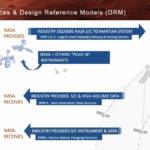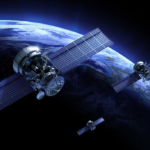HELSINKI — The Chinese Academy of Sciences (CAS) is backing a new suite of diverse, cutting edge missions, advancing its ambitious agenda in space science.
The initiatives—spanning lunar farside astronomy, astrophysics, exoplanets and heliophysics—aim to place China at the forefront of astronomical research and space exploration. Wang Chi, director of the National Space Science Center (NSSC) under CAS, revealed the missions at the annual Zhongguancun Forum meeting April 27.
Selected missions include Discovering the Sky at the Longest Wavelength (DSL), the Enhanced X-ray Timing and Polarimetry (eXTP) mission, and the ExoEarth Survey, an exoplanet-hunting spacecraft. Another mission will see a spacecraft sent to observe the solar poles. The Taiji mission will use three satellites to detect gravitational waves.
The missions are separate from the China National Space Administration’s planetary and lunar exploration programs. These are known as Tianwen and Chang’e respectively.
The eXTP mission will be a powerful X-ray observatory to monitor the sky and enable multi-messenger studies for gravitational waves and neutrino sources. It will also study the universe under extreme states of matter density, gravity and magnetism.
DSL will consist of an array of 10 small satellites sent into lunar orbit. The nine spacecraft and one mother spacecraft will use the moon as a shield against Earthly electromagnetic interference to enable it to pick up faint, ultra-long wave signals from the early universe.
The ExoEarth Survey, likely a mission also referred to as “Earth 2.0,” or ET, will use the transit, photometry and microlensing methods to search for terrestrial planets and rogue planets. The selected solar mission appears to refer to the previously proposed Solar Polar-orbit Observatory (SPO). This aims to study poles of the Sun, orbiting at an inclination of greater than 80 degrees with respect to the plane of the ecliptic.
Taiji will consist of three spacecraft in heliocentric orbit, building on earlier experimental missions. These will create an ultra-long baseline of 3 million kilometers to detect medium and low-frequency gravitational waves. It is centered on research into the nature of gravity and space-time.
The missions largely come from an earlier round of 2022 candidate missions as part of an expected third Strategic Priority Program (SPP III) to be initiated by CAS.
Of the 13 proposals, 5-7 missions were expected to be selected. It appears however that a new space science program is being created, though still selecting from proposals under SPP III.
| Category | Missions |
|---|---|
| Space Astronomy and Astrophysics | 1. Enhanced X-ray Timing and Polarimetry (eXTP) |
| 2. DArk Matter Particle Explorer-2 (DAMPE-2) | |
| 3. Discovering the Sky at the Longest Wavelength (DSL) | |
| Exoplanets | 1. Closeby Habitable Exoplanet Survey (CHES) |
| 2. Earth 2.0 (ET) | |
| Heliophysics | 1. SOlar Ring (SOR) |
| 2. Solar Polar-orbit Observatory (SPO) | |
| 3. Earth-occulted Solar Eclipse Observatory (ESEO) | |
| 4. Chinese Heliospheric Interstellar Medium Explorer (CHIME) | |
| Planetary and Earth Science | 1. E-type Asteroid Sample Return (ASR) |
| 2. Venus Volcano Imaging and Climate Explorer (VOICE) | |
| 3. Climate and Atmospheric Components Exploring Satellites (CACES) | |
| 4. Ocean Surface Current multiscale Observation Mission (OSCOM) |
None of the missions proposed under the pillar of planetary and earth science appear to be selected. However, there remains the possibility that one or more these are selected under a separate track of missions. A mission to Venus, as proposed by a team SPP III, remains of great interest to China’s planetary science community.
The new missions will follow the first and second round of Strategic Priority Program on Space Science missions. The first included the DAMPE dark matter probe, HXMT X-ray observatory, Shijian-10 recoverable satellite and Quantum Experiments at Space Scale (QUESS) missions. launched across 2015-2017.
SPP II missions include the Einstein Probe which launched early this year and the upcoming Solar wind Magnetosphere Ionosphere Link Explorer (SMILE) in collaboration with the European Space Agency. The Electromagnetic Counterpart All-sky Monitor (GECAM) and the Advanced space-based Solar Observatory (ASO-S) were also launched in recent years.
Meanwhile China is set to launch its Chang’e-6 lunar far side sample return mission from Wenchang spaceport May 3.
Related
Author Profile
- Space.com is an online publication focused on space exploration, astronomy, skywatching and entertainment, with editorial teams based in the United States and United Kingdom
Latest entries
 ScienceMay 12, 2024National Space Council will explore military space and intelligence roles and responsibilities
ScienceMay 12, 2024National Space Council will explore military space and intelligence roles and responsibilities ScienceMay 5, 2024NASA awards studies for commercial Mars missions
ScienceMay 5, 2024NASA awards studies for commercial Mars missions ScienceMay 4, 2024Air Force project blends military and commercial space networks
ScienceMay 4, 2024Air Force project blends military and commercial space networks ScienceMay 4, 2024Nelson lobbies Congress to fund ISS deorbit vehicle in supplemental spending bill
ScienceMay 4, 2024Nelson lobbies Congress to fund ISS deorbit vehicle in supplemental spending bill

